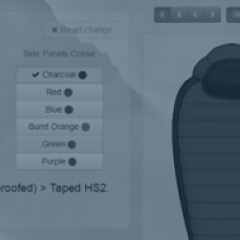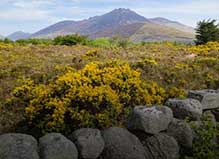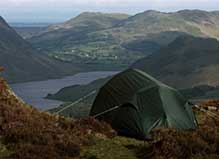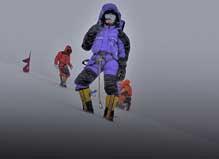Windchill
Windchill is the name used for the deadly combination of wind and cold. In countries with harsh winters like Canada windchill figures are routinely quoted in the news and the word has even become common in weather forecasts in the temperate UK. It is a useful, but often misunderstood, piece of information.
Windchill Table
| Wind Speed mph/kph | Air Temperature °C | |||||
|---|---|---|---|---|---|---|
| 0/0 | 0 | -10 | -20 | -30 | -40 | -50 |
| Windchill Temperature °C | ||||||
| 10/16 | -6 | -19 | -31 | -44 | -57 | -70 |
| 20/32 | -8 | -22 | -35 | -49 | -62 | -76 |
| 30/48 | -9 | -24 | -38 | -52 | -66 | -80 |
A. The Figures
Windchill is quoted as a figure. "The temperature will be zero centigrade, but in the strong breeze the windchill will be minus 8C." This figure of –8C is the combined effect of air temperature and wind on the human body without clothes, on bare skin. Anyone in a bikini will feel the full effects! The raw figures do not apply to clothed parts of the body.
Of course in very cold conditions quoting windchill does have a serious value, as it gives a useful indicator of the danger of frostbite in exposed parts of the body such as face and hands. For example at –30C a 30mph wind will drop the effective temperature for exposed areas to –52C and frostbite can be expected to start affecting them in about five minutes—well worth a warning.
B. What the figures mean
The actual air temperature is not changed by the wind. What changes is the effect on us.
The human body is sometimes compared to a factory which produces heat at its core. As that heat dissipates outwards through the outer parts of the factory, it warms them and grows cooler in the process. When it reaches the outer wall (our skin), it warms that too, then comes into contact with the air outside. If the air is colder than our skin, the last of the spreading heat warms a thin layer of air too before equilibrium is reached with the surrounding temperature and the whole process stops.
This layer of air, this mini-atmosphere, surrounds our bodies all the time and adds roughly the equivalent of a thin wool sweater (about 0.8 Clo) to our insulation. The first action of wind is to strip away this invisible outer layer. A 10mph wind is enough to remove about 70% of it: at 50mph it will remove 90%. This is the basic message that windchill figures are trying to convey—what little natural insulation we have to protect our exposed parts is soon gone as the wind rises.
But few people go out naked in cold weather. We wear clothing, often thick clothing, which can provide up to another 5 or 6 Clos of insulation. And if the outer fabric can keep out the wind, it appears that whatever the windspeed all we are at risk of losing is the minor amount of insulation from our 'atmosphere'. For the 90% of our body which is clothed wind will make no appreciable difference. So take care of hands and feet, and then ignore windchill. Is it this simple? Not quite.
C. Windchill and Clothing—Figures
Windspeed can actually affect the insulation offered by our clothing in three ways: by penetration, by ingress, and by compression. Since most of the insulating value is provided by so-called 'dead' air in and between the layers of clothing, any disturbance of that air will reduce its effectiveness.
Penetration: Wind can come straight through our outer clothing (fleece etc).
Uncoated woven fabrics are all permeable to some degree. When they are used as outers for clothing, direct wind penetration may lead to a substantial loss of insulation from our clothing layers. At very low windspeeds this effect is likely to be negligible. At 30mph a garment with a tightly woven cotton outer can lose up to 40% of its insulation value, while a down jacket with a glazed downproof outer can lose up to 10%.
The message is obvious. In cold windy places wear clothing with a totally windproof outer fabric.
Ingress: Wind can also penetrate our defences via the gaps in our clothing.
When we walk or climb, the movement pushes warm air out of every gap in our clothing. This is called the 'bellows effect' and is often very useful: movement warms us up and this natural ventilation system can reduce the total insulating effect of our clothes by up to 50%—and that's without any help from the wind.
But when conditions are extremely cold and windy, this useful effect becomes a liability. Not only are we leaking heat we want to keep, we also allow the cold wind to force its way in down the same gaps and replace our warm dead air with something much less friendly. So at neck, wrists, waist, ankles, all the places it's so good to ventilate when we're hot, we must be able to close down tight when it's necessary.
Compression: High wind can flatten our insulation and reduce its value
Warm gear is usually thick and soft, the filling (whether down or synthetic) having expanded to trap as much air as possible. High wind speeds will compress the filling to some degree with an insulation loss of anything up to 15%.
Summary: Windchill & Clothing
Add up all the figures and it looks scary. Either we shouldn't risk going out in high winds or we need twice as much insulation as we thought we did! It's so often the same with figures—take them at face value and you're likely to end up with nonsense.
Experienced outdoor people already know the answer. If you're going somewhere very cold and windy (Everest, Denali or Antarctica are all good examples), then you need:
- a totally windproof outer which reduces direct wind penetration to zero
- good closures at all points of potential wind ingress (plus useful stoppers like neck gaiters)
That leaves compression as something we can do little about, but by the time the wind speed is high enough to flatten our insulation significantly, we'll probably be looking for shelter.
D. The Figures—Conclusion
Quoted Windchill figures serve a real purpose as a warning about the great care we may have to take of our exposed parts to avoid frostbite. For the rest of the body, the main part of us, if we take certain precautions, they seem to have very limited application, and the parameters involved in calculating the effect of wind on different clothing assemblies are so complex that they cannot lead us to any simple usable information. So at this point let's abandon the calculations and look at real experience.
E. Windchill—Human Experience
Just as we tend to be overimpressed by the bald windchill figures we hear, we also incline to thinking that the right gear makes them irrelevant. The reality lies somewhere in between.
Comfort
Our tolerance to cold is usually limited by our coldest bits. If your torso is nice and warm, but your hands are freezing and your nose is dropping off, which message is going to register? So you may have exactly the right main gear for coping with cold windy weather, but if you let your extremities get too cold, you are likely to find yourself turning back. Windchill is only affecting small parts of you, but the effects can be disproportionately large.
Survival
Assuming you have completely windproof clothing, what are the ultimate dangers from windchill? We're talking about survival here, not frostbite.
First that same point of vulnerability, the hands. If you are able to keep insulated windproof mitts on all day, you're probably going to avoid this hazard. Unfortunately that is often not possible—sorting gear, adjusting gear or clothing, taking photographs, all sorts of things are difficult to do in big mitts. If you are quick (we are talking about severe windchill), then your cold fingers should recover when you are moving again. If they remain cold and clumsy, then you have an additional difficulty on your climb/expedition, which may end up compromising your safety if it gets any worse.
The second danger comes if you are stationary. You are producing much less heat than when you are in motion, so your insulation may be performing at its limit to keep you warm. In this situation (for example a bivouac without shelter) windchill could be the final factor which tips the balance, moving you from heat balance into heat deficit. Even the small extra heat loss from the outside of your windproof clothing might be more than you could afford.
Windchill - basic rules
- In mountains, polar areas or remote wilderness take windchill seriously
- In areas known for windchill take it very seriously
- A totally windproof outer shell is essential
- Take extra care for your extremities, particularly your hands
Note: Only the physical aspects of windchill have been outlined here, without any reference to the body’s physiological responses to cold.




















